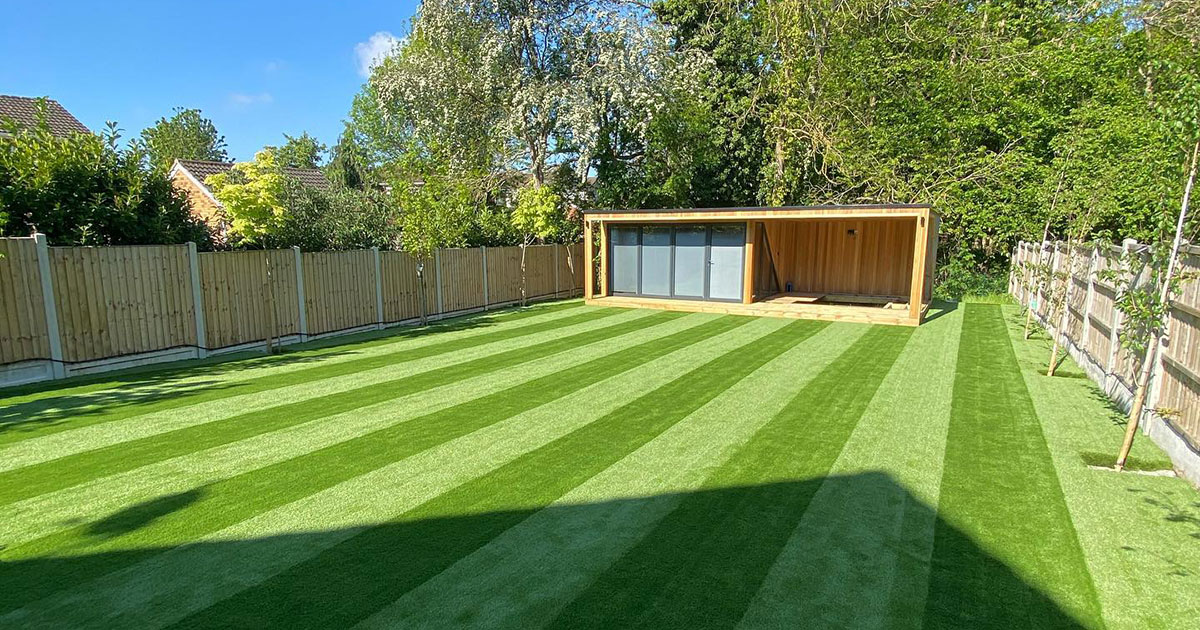We Supply. We Install. We Do it All.
Essex Artificial Grass Experts
Maybe your neighbour recently got artificial grass installed in their front garden. Or perhaps you came across a photo of a stylish backyard with artificial grass on social media.
Your interest is piqued.
Here we outline eight pros and six cons when it comes to artificial grass installation. Ultimately, though, the choice will depend on your unique circumstances and lifestyle.

Artificial Grass Pros and Cons: The Ultimate List
This is the big one. While real grass lawns require a lot of care and upkeep, you don’t need to water, mow, weed, or fertilise artificial grass. Plus, there’s no mud, so you also save time wiping muddy footprints or pawprints inside the house too.
To keep artificial grass looking good, all you need to do is remove debris using a leaf blower, rake, or brush, and hose it down with some detergent if it gets dirty.
Being so low maintenance makes artificial grass a particularly good choice for elderly people or those often away from home. It’s also a great option for landlords as they don’t have to worry about tenants remembering to mow the lawn.
In hot weather, there’s no danger of artificial grass drying out, going yellow, or dying. It will maintain its lovely vibrant green colour no matter how much the sun shines. And as long as it’s been installed correctly by a professional, artificial grass offers good drainage in heavy rain and can even dry faster than natural grass.
On a similar note, artificial grass can be installed in shady areas, unlike real grass which will struggle to grow and look healthy without adequate sunlight.
Hose-pipe bans are becoming increasingly common in this country. Artificial grass has a major advantage over real grass because it doesn’t need to be watered. Not only is this good for the environment as it reduces water usage, but it also allows you to save money on your water bills.
There’s nothing worse than seeing your puppy get to work digging a hole in your perfectly groomed lawn. But with artificial grass, such woes are forgotten. Fake grass can’t be dug up or spoiled and it’s also unaffected by pet urine. Plus, it’s easy to clean with water and detergent.
Once you add up the combined cost of pesticides, fertilisers, lawnmowers, hoses, strimmers, and so on, having a real lawn can be quite costly. And while artificial grass installation involves an initial financial outlay, it quickly pays for itself.
Kids can mess up a lawn, no matter what you do. Artificial grass is not only play-resistant but also offers a cushioned surface to protect children from falls and bumps. Plus, there’s no need for any pesticides or other chemicals, making it an extra safe option for kids.
More than 10 million people suffer from hay fever in the UK. But with artificial grass, there’s no pollen. So, no more stuffy noses and itchy eyes.
There’s a whole range of artificial grass options on offer so you can choose according to your tastes and needs. Pick from different colours, piles, textures, yarns, and densities to create a different look and feel depending on your unique garden.
When discussing why artificial grass is bad, the environmental effect is typically the first thing people will mention. And it’s true.
Depending on production methods, artificial grass can be bad for the environment. Plus, they’re made out of plastic which ultimately will end up in a landfill site somewhere. On the other hand, artificial grass doesn’t require the use of any pesticides which are bad for the environment. And pollution from petrol lawnmowers is not insignificant either.
The initial expense of artificial grass installation can put people off. However, due to the low maintenance of fake grass, it starts to pay for itself over time. Plus, more expensive artificial grass is of higher quality and doesn’t contain the toxins that cheap fake grass tends to.
Artificial grass can take time to install. But ensuring it’s installed properly by employing the services of a professional artificial grass company is important so that your artificial grass looks perfect and lasts a long time.
Some people point out that natural grass lasts forever, unlike fake grass. However, artificial grass can still last up to 15 or 20 years with the right maintenance.
In high temperatures, artificial grass can heat up. However, giving it a quick spray with the hose will keep it cool—or simply lie on a towel if you want to sunbathe.
Environmentalists complain about the lack of biodiversity when it comes to artificial grass. But there’s no reason why you can’t still have real trees, flowers, and shrubs alongside your fake grass, providing plenty of habitat for different species.
What’s more, new research suggests that lawns aren’t particularly good for biodiversity anyway because they’re a monoculture.
For most people, the pros of artificial grass will outweigh the cons. The minimal maintenance requirements, durability, and weather resistance, all make it a very tempting choice.
At the end of the day, however, the choice is yours and depends on your unique garden and circumstances. Give us a call today and we can help you with your decision.
Like this article?
